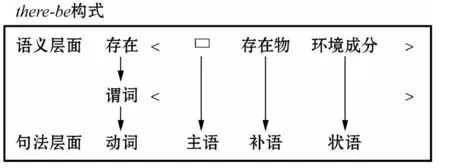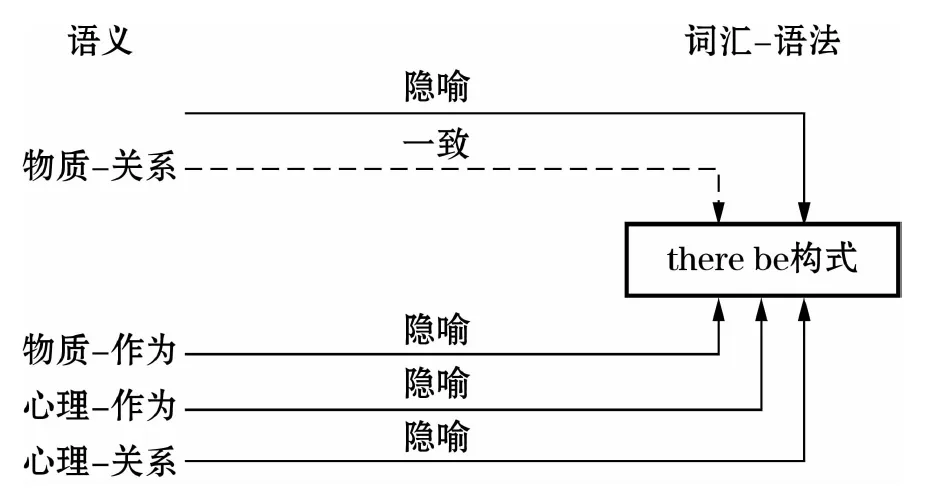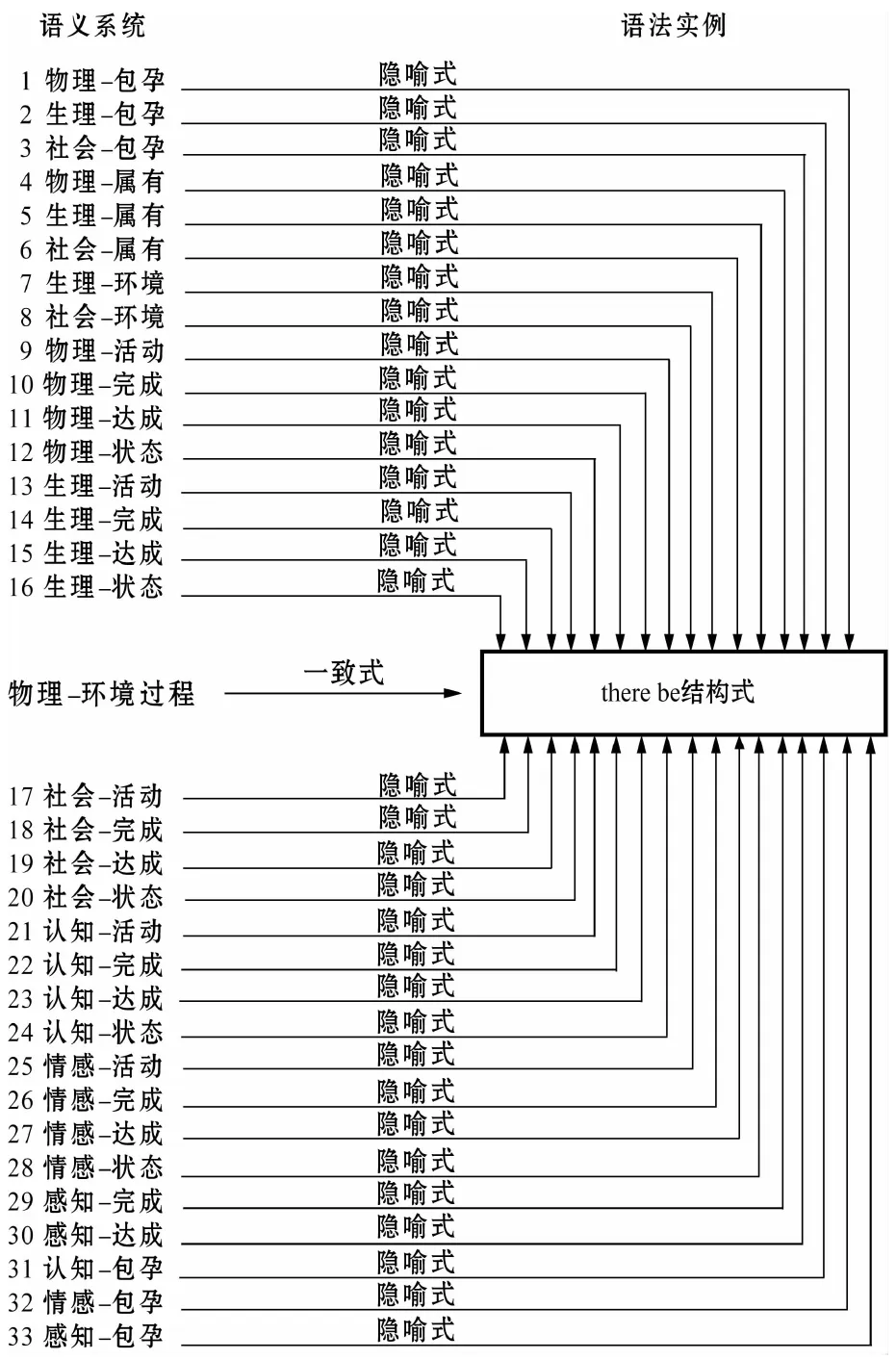英语的there be构式及其隐喻系统
——基于SFG及物性新模式的专题研究
柴同文
(中国石油大学,北京,102249)
1. 引言
韩礼德(Halliday 1985,1994;Halliday & Matthiessen 2004)的及物性系统(Transitivity)把人类经验识解成六个过程类型:物质(Material)、心理(Mental)、关系(Relational)、言语(Verbal)、行为(Behavioural)和存在(Existential)①。每个过程都有自己的语义配置方式。例如,
(1) The lion [动作者]caught[过程:物质] the tourist [目标].
(2) Mary [感知者]liked[过程:心理] the gift [现象].
从语法(即识解)的角度来看,韩礼德的分类堪称经典,因为他把纷繁复杂的人类经验高度抽象并概括为有限的几个过程类型,从而使我们通过意义(这里指词汇-语法)识解经验变得简单可行(试比较:Quirketal. 1985;Lock 1996;Taylor 2002;Dirven & Verspoor 2004)。例如,要表达“第五天他们到达了山顶”这一意义,说话人或作者既可以选择物质过程,如(3a),也可以选择心理过程,如(3b),完全取决于说话人的交际意图和语境。
(3) a. On the fifth day they arrived at the summit.
b. The fifth day saw them at the summit. (Halliday 1994: 344)
但是,从语义(即编码)的角度来看,韩礼德对过程的分类还值得商榷。因为,在我们(彭宣维2003,2010;柴同文2010a)看来,物质过程和心理过程均可以还原为物质(外部)和心理(内部)两种经验域。相反,其他过程则无法向上一层经验域还原,或者还原得不够彻底。例如,一部分关系过程可以还原为物质经验域,而另一部分可以还原为心理经验域(Halliday & Matthiessen 2004:120-212)。试比较:
(4) a. My name is Alice.
b. She is in the dining room.
c. Emily has a piano
(5) a. She is happy.
b. It seems encouraging.
c. His behavior is amusing (to her)
2. SFG及物性系统新模式
对于过程与经验域之间的矛盾,彭宣维(2010:131)提出了自己的看法。他认为,上述问题的出现主要是因为经典及物性理论②“没能把编码前不成形的经验域和编码本身的识解和表征区别开来”。换句话说,通常意义上的经验还处于一种抽象的“前语法化”阶段(Palmer 1964:130;另见Halliday 1966/1976:98),还是一种零散混沌的东西,因而并无形式可言;只有通过某些表征手段,才能使之成为可识别的经验知识,从而表现为各种范畴,进而成为具有交际功能的命题或提议。因此,彭宣维(2005,2010)认为所谓的“关系”不应该是一个过程,而是一种构式化了的表征手段(structural representation),即构式(construction)。只有这样,我们才能说“关系”过程是对“所有经验域”的识解(Halliday & Matthiessen 2004:214)。依据这一思路,彭宣维(2005,2010)提出了及物性研究的新思路。
首先,他沿用了韩礼德的物质、心理经验二分法③,但把物质经验进一步分成了物理(physical)、生理(physiological)和社会(societal)三个次类。物理经验指的是人类对客观世界里非生命体(non-animate)的经验表征,如the sun rises in the east and sets in the west。与物理经验不同,生理经验和社会经验所关涉的是有生命体(animate)的行为、活动或状态。前者侧重于个体活动,如thebirdflewaway,后者具有一定的社会性和交互性(interactive),例如,my parents always praised me when I did well at school。
其次,他从众多的语言实例中识别出两种典型的表征方式:关系(relational)和作为(operational)。“关系”表征方式仍然遵从韩礼德模式:包孕型(intensive)、属有型(possessive)和环境型(circumstantial)(Halliday 1985,1994;Halliday & Matthiessen 2004)。“作为”表征方式借用了Vendler(1957)的分类模式:活动、完结、达成和状态(见主持人语)④。这样,以“物质”和“心理”两种经验域为纵坐标,以“作为”和“关系”为横坐标,就可以生成四个新的过程类型:物质-作为、物质-关系、心理-作为和心理-关系。
3. 对存在过程的重新审视
在经典及物性理论中,韩礼德将存在过程看作是一种次要类型,“位于物质过程和关系过程的交界处”,表征的是“事物的存在或发生”(Halliday 1994:107),属于物质经验的范畴。请看下例:
(6) a. There is a dog in the garden.
b. There is a man at the door.
同关系过程一样,存在过程也可以用来识解心理经验域(柴同文2008,2009,2010a,b)。例如:
(7) a. There was littleunderstandingof acoustics.
b. There is nodoubtabout the answer.
c. There stirred in his mind an oddfeelingofannoyancewith Roderick for having thus peremptorily enlisted his sympathies.⑤
基于此,我们认为存在过程应该与there be构式区分开来:前者是个语义范畴,后者是个语法范畴。两者之间的关系如下图所示:

图1therebe构式的语义-语法特征
那么,为什么要做此区分呢?在回答这个问题之前,我们有必要先来回顾一下韩礼德的“扩展模式”(extended model,该术语是韩礼德与彭宣维私下交流时使用的)。该模式(Halliday 1995/2002:254-255)主张将“语言实例”(instance)从“语言系统”(system)中分离出来。具体说来,他用语义(semantics)、语法(lexicogrammar)、音系(phonology)来指称语言的系统,而用意义(meaning)、措辞(wording)和语音(sounding)来指称语言的实例(另见Eggins 1994/2004:19)。这就形成了“实体化/层次化矩阵”(instantiation/stratification matrix)(Halliday 1995/2002:254)⑥。基于这一模式,彭宣维(2003)主张将经典理论中的词汇-语法层一分为二:语义范畴应该是语言的语义层,而语法范畴则属于语法层。例如,在小句的概念元功能层面,可以将实例性的及物性意义和实例性的主语语法范畴区别开来。换句话说,在小句层面上,及物性是它的语义范畴,而相应的语法形式范畴是“主语构式”(subject construction):由主语和谓语两部分构成(subject+predicate)⑦。请看下面的例子:
(8) a. He broke the window. [物质]
b. She likes the gift. [心理]
c. The cat is on the mat. [关系]
d. She laughed heartedly. [行为]
e. I said that you should keep quiet. [言语]
在这里,尽管各小句的过程类型不同,经验域也不同,但它们共享一个高度抽象的句法形式:“主语+定式操作语+述语+补语+状语”,即主语构式(彭宣维2006)。
那么,存在过程的主语构式如何呢?且看下例:
(9) a. There is a fly in the soup.
b. Is there a fly in the soup?
c. There is a fly in the soup, isn’t there?
按照韩礼德的分析,例(9)中的主语应该是there,因为它和操作词is一起构成了该小句的语气:主语在前,操作词在后,小句选择直陈语气;操作词在前,主语在后,小句选择疑问语气。但这里有两个问题,第一,本例中的there并不承担任何经验意义(Halliday & Matthiessen 2004:257);第二,做主语的通常是一个名词(词组)或者代词。显然,there不符合主语的条件。这样一来,势必要求小句的其他成分来充当主语。那么,谁能成为小句的主语呢?通常情况下,我们可以通过两条规则来判断小句的主语:(1)作主语的名词词组与操作词之间有“数”的一致关系;(2)主语在附加疑问句中以代词的形式出现。试比较:
(10) a. There are five boys in the class.
b. There are five boys in the class, aren’t there?
依据第一条规则,five boys应该是主语;依据第二条规则,there应该是主语。综合考察上述两条规则,我们(彭宣维2003;柴同文2010a)认为there be构式中的主语应该是位于动词之后的那个名词词组,而非there,后者只是一个语气“互动成分”(彭宣维2003),它所承载的只有人际意义和语篇意义,没有概念意义。另外,教学语法的有关知识也告诉我们,there be构式一直被看做是英语的基本句型之一(Bolinger 1981;Quirketal. 1985;Biberetal. 2000;Huddleston & Pullum 2002)。
据此,经典功能语法理论中所说的“及物性”其实是一个经过词汇-语法手段识解或构式化了的经验意义范畴,而“主语”及其相应的构式关系,即“主语构式”应该是一个经验性的措辞(wording)范畴,二者之间的关系是“及物性→主语构式”(彭宣维2003)。依此,经典及物性系统中的存在过程也是个意义范畴,而对应的there be构式则是一种构式化了语法表征手段,是一种特殊的主语构式⑧。
4. there be构式的隐喻系统
至此,我们解决了经典及物性理论中经验域与过程之间的矛盾关系,也从理论上界定了there be构式的本质特点。下文将在SFG及物性新模式框架下,详细探讨这一构式的语义特征,尤其是它的隐喻表征系统。
语料分析表明,典型的there be构式是表征“物质-关系”经验的,具体说来,应该是“物理-环境”过程(即xis ata)。但它可以隐喻识解“物质-作为”过程、“心理-作为”过程、“心理-关系”过程、以及“生理”和“社会”类“物质-关系”过程。换言之,“物质-作为”经验、“心理-作为”经验、“心理-关系”以及部分“物质-关系”经验均可以通过there be构式而得以重新识解(reconstrue),产生多种隐喻。如图2所示。

图2therebe构式的隐喻系统
4.1 there be构式识解“物质-关系”经验
总的说来,该类隐喻是表达“物理-环境”经验的there be构式(即xis ata)作为源范畴使用,被“映射”(mapping,见Lakoff & Johnson 1980/2003)或/和“整合”(blending,参见Fauconnier & Turner 2002)到“物质-关系”目标域上而产生的。根据表征方式,我们把它们分成了三类:包孕型,属有类和环境类。每个类型都有自己的次类范畴。分别举例说明如下。
先来看包孕型,主要有三种次类。
ⅰ. “物理-包孕”类
(11) a. There are three rooms available: one double, one single and a family room.
b. Three rooms are available: one double, one single and a family room.⑨
ⅱ. “生理-包孕”类
(12) a. [...] about his body there was a peculiar springiness, or resiliency, almost catlike.
b. It was springy, or resilient; it is almost like a cat.
ⅲ. “社会-包孕”类
(13) a. There is present in this hall today a number of people who are concerned with the future of Skelton.
b. A number of people are present in the hall today.
再来看“属有”类“物质-关系”过程的隐喻识解,也有三种类型。
ⅳ. “物理-属有”类
(14) a. For Fraser, there were model aeroplanes.
b. Fraser had model aeroplanes.
ⅴ. “生理-属有”类
(15) a. For most birds, there is a distinct to build nests.
b. Most birds have a distinct to build nests.
ⅵ. “社会-属有”类
(16) a. But there were so many choices in front of you.
b. Now, you have so many choices.
最后是“环境”类。共有两种情况。
ⅶ. “生理-环境”类
(17) a. There were two other dogs on the ship.
b. Two other dogs were on the ship.
ⅷ. “社会-环境”类
(18) a. There were three ladies in the room and one gentleman.
b. Three ladies and one gentleman were in the room.
4.2 there be构式识解“物质-作为”经验
同样,当表征“物理-环境”经验的there be一致式被作为源范畴使用,被映射或/和整合到“物质-作为”经验目标域时,也会产生语法隐喻。根据经验类型,我们将它们分成了三类:物理类、生理类和社会类。分别举例说明如下。
先来看“物理-作为”类,主要有四种情况:
ⅰ. “物理-活动”类
(19) a. There was a strong wind blowing that day too, out of a dark, cloudy sky.
b. A strong wind was blowing that day too.
ⅱ. “物理-完结”类
(20) a. There was a change of climate here.
b. The climate has changed here.
ⅲ. “物理-达成”类(physical-achievement)
(21) a. Suddenly, there was an explosion.
b. Suddenly, something exploded.
ⅳ. “物理-状态”类
(22) a. And in the latter of the garden there grows a very fine example of a Judas tree.
b. A very fine example Judas tree grows in the latter part of the garden.
再来看“生理-作为”类,主要有四种次类型:
ⅴ. “生理-活动”类
(23) a. There came a roar and a rumbling from behind us.
b. Some was roaring and rumbling from behind us.
ⅵ. “生理-完结”类
(24) a. There must have been an increase in the number of different kinds of animals and plants since the Precambrian.
b. The number of different kinds of animals and plants are increasing since the Precambrian.
ⅶ. “生理-达成”类
(25) a. There has been a death in his family.
b. Someone in his family has died.
ⅷ. “生理-状态”类
(26) a. There lives a grass snake in a small pond.
b. A grass snake lives in a small pond.
最后是“社会-作为”类,也有四种情况:
ⅸ. “社会-活动”类
(27) a. And there was such a scuffling, and hugging, and kissing and crying, with the hysterical YOOPS of Miss Swarts.
b. People were scuffling, hugging, and kissing and crying with the hysterical YOOPS of Miss Swarts.
ⅹ. “社会-完结”类
(28) a. There has been unprecedented industrial expansion.
b. The industry has been expanded unprecedentedly.
ⅹⅰ. “社会-达成”类
(29) a. There has been a promise that prosperity will be permanent.
b. The government promised that the prosperity will be permanent.
ⅹⅱ. “社会-状态”类
(30) a. At the end of the Boulevard there sits the enormous Catherine Palace, baroque and three times the size of the Alexander Palace.
b. The enormous Catherine Palace sits at the end of the Boulevard.
4.3 there be构式识解“心理-作为”经验
此类隐喻是将表征“物理-环境”经验的there be一致式(xis ata)当作源范畴使用,映射或/和整合到“心理-作为”经验目标域时产生的。从经验类型上来看,也有三种类型,每一类都有自己的次类范畴。先来看“情感-作为”类经验的隐喻识解,共有四种情况:
ⅰ. “情感-活动”类
(31) a. There was a cheer as Abuelo Freitas and Constance Richards stood up together.
b. The audience were cheering as Abuelo Freitas and Constance Richards stood up together.
ⅱ. “情感-完结”类
(32) a. While all this was hugely satisfactory, there was a longing for a winner from closer to home.
b. People were longing for a winner from closer to home.
ⅲ. “情感-达成”类
(33) a. There was a satisfaction about it.
b. I was satisfied with it.
ⅳ. “情感-状态”类
(34) a. There is a fear that some of young people don’t want peace, at any price.
b. People usually fear that some of young people don’t want peace, at any price.
再来看“认知-作为”类经验的隐喻表征,共有四种情况:
ⅴ. “认知-活动”类
(35) a. However, there is still a lingering doubt about the justification for such a rise.
b. The experts are still doubting about the justification for such a rise.
ⅵ. “认知-完结”类
(36) a. There is always a recall of the gory accident in his life.
b. He always recalls that gory accident in his life.
ⅶ. “认知-达成”类
(37) a. Increasingly, then, there is a recognition that the products of education and business are the twin pillars...
b. People recognize that the products of education and business are the twin pillars...
ⅷ. “认知-状态”类
(38) a. There is a widespread belief that when we are born we are like a blank sheet of paper on which life began to write.
b. Most people believe that when we are born we are like a blank sheet of paper on which life began to write.
最后是“感知-作为”类经验的隐喻识解,共有两种情况:
ⅸ. “感知-完结”类
(39) a. There was watching enough, now.
b. They have watched it enough.
ⅹ. “感知-达成”类(perceptive-achievement)
(40) a. There was now appearing a sort of fourth estate of little red-and-white rough-cast villas.
b. Now, we saw a sort of fourth estate of little red-and-white rough-cast villas.
4.4 there be构式识解“心理-关系”经验
最后,there be构式还可以隐喻识解“心理-关系”过程及其次类。这是表征“物理-关系”经验的there be一致式xis ata被映射或/和整合到“心理-关系”目标域的结果。主要有以下三种类型:
ⅰ.“情感-包孕”类
(41) a. ... there are disappointments and frustration, but I find it fun!
b. Sometimes I felt disappointed and frustrated, but I find it fun!
ⅱ. “认知-包孕”类
(42) a. There’s a confidence in the people that heretofore wasn’t there.
b. People are confident that heretofore wasn’t there.
ⅲ. “感知-包孕”类
(43) a. There were houses in sight on the right.
b. On the right, many houses are in sight.
以上我们探讨了there be构式的隐喻系统,共涉及到了四个类型的33种隐喻类型,如图3所示:

图3therebe构式的隐喻系统
至此,我们得到了一个较为精密的关于经验意义与其相应形式范畴(即there be构式)之间的对应模式。还里有几点说明。
首先,所有隐喻类型均属于韩礼德的语法隐喻范畴,因为隐喻的目的都是通过扩展语义来识解人类经验。具体说来,there be构式涉及的所有隐喻都是在实例化,即从系统成分到实例性构式的生成过程中产生的。从根本上来说,那些已经进入系统的隐喻也是从实例化过程中编码过来的。
其次,所有隐喻都涉及到一个语义域重构为另一个语义域的问题。从认知的角度来看,所有隐喻都是“物质-关系”,具体说是“物理-环境”始源域(主要是包孕和属有型)向“物质-关系”、“物质-作为”、“心理-作为”和“心理-关系”目标域及其次类范畴映射或/和整合的结果。
最后,所有隐喻都是以构式的形式体现出来。事实上,所谓there be构式中的隐喻,就是表达“物质-关系”经验的there be一致式(xis ata)被隐喻性地当作“物质-关系”构式(xisa,xhasa),“物质-作为”构式(xdoesa),“心理-作为”构式(xsensesa)以及“心理-关系”构式(xisb,xhasb)来使用,进而识解人类各种经验的。
5. 结语
本研究回顾和梳理了韩礼德的经典及物性系统,指出了过程类型与经验域之间的矛盾,重新界定了关系过程,将它看作是一种构式性的表征手段。进而详细介绍了系统功能语法及物性研究的新模式,在此基础上探讨了英语存在过程的语义和语法特征,认为存在过程是个语义范畴,而对应的there be构式则是它的词汇-语法体现形式,是一种语法化了的构式表征形式,一种特殊的主语构式。基于这一论断,本文采用功能-认知研究方法,对这一语法构式所涉及的33种隐喻进行了详细描写和解释。研究发现,there be构式所引发的隐喻是从语义系统到语法构式的实例化过程中产生的,是物质-关系域对物质-作为、心理-作为以及心理-关系域的重构,属于语法隐喻范畴,但具有认知属性,以构式为基础。
本文整合认知语言学中的构式语法理论和系统功能语言学的相关思想来解释及物性系统,主要是因为二者都是基于使用的语法模式,都从整体上分析语言构式,都强调形式与意义的一体性。这一做法的主要目的是从不同的角度来审视和考察及物性系统,为隐喻研究提供新思路。但要实现功能与认知研究的真正结合,无疑还有很长的路要走。
附注
① 除了这里提到的六个过程以外,在“存在”过程与“物质”过程的交界处,还有一个和天气有关的特殊过程范畴:气象过程(Meteorological)。例如,it’sraining、thewindisblowing、there’sgoingtobeastorm等。
② 本文把韩礼德早期的理论模式(Halliday 1967-1968,1985,1994)称之为“经典理论”,以此与他的“语言扩展模式”(extended model,Halliday 1995/2002)相区别。
③ 新模式沿用韩礼德(Halliday 1985,1994)对心理经验的分类:感知(perceptive)、认知(cognitive)和情感(affective)。其中,情感范畴借用了马丁(Martin & White 2005)的分类模式,即情感(emotive)和意愿(desiderative)。
④ 根据“体”(aspect)特征,即事件内部的时间特征,Vendler(1957)将动词分成了四类:“活动”动词、“完结”动词、“达成”动词和“状态”动词。其中,“活动”动词表达的是“没有自然终结点的持续性动作”,如walk、swim等;“完结”动词用以指称“有自然终结点的持续性动作”,如build a house、eat an apple等;“达成”动词指称的是“有自然终结点的瞬间动作”,如die、reach等;“状态”动词则用来指称“具有持续性的静止状态“,如be tall、have a book等。将Vendler(1957)的动词模式整合到系统功能语言学的及物性系统以后,我们发现,动作类型(如doing、sensing、saying、being、having等)在时间维度上得到了具体化,这使得原本抽象的及物性系统变得更加精密了。例如,对于物质过程,我们可以把它分成四种类型来描述:(1)活动类,如acatwaswalkingalongthetopofthefence;(2)完结类,如shehadmadeachocolatecake;(3)达成类,如theyfinallyreachedthecoastafterfiveweekssailing;(4)状态类,如hesmokeseveryday。
⑤ 本文部分例句来自作者(柴同文2010a)的博士论文“系统功能语法及物性新模式视角下的英语存在句构式的隐喻系统研究”。
⑥ 该矩阵包括三个单元:(1)系统,包括文化、语义和词汇-语法系统三个层次;(2)子系统/实例类别,包括制度/情景类别、语域/语篇类别三个层次;(3)实例,包括情景、“[语篇作为]意义”以及“[语篇作为]措辞”三个层次。从“系统”到“子系统/实例类别”再到“实例”就是“实例化”,从“语境”层到“语义”层再到“词汇-语法”层,就是“层次化”。
⑦ 在经典理论中,主语被看做是一个“人际”概念,因为它与限定词一起构成了小句的语气构式。但彭宣维(2002,2003,2006,2011)和彭宣维等(2007)认为韩礼德从命题和提议出发,将主语分析为一个人际性语法次范畴的做法是不恰当的。原因在于命题和提议是一个同时具有概念性和人际性的复合概念,韩礼德只看到了人际性的一面,而忽略了其概念性一面,因而是经不起推敲的。
⑧ 其他类型的主语构式还有“it-cleft”和“wh-cleft”分裂句等。相关分析,请见彭宣维(2003)。
⑨ 在隐喻实例分析中,我们提供了两个小句,其中a句是隐喻性的there be小句,b句则是根据其意义特征还原而成的一致表达式。
Bolinger, D. 1981.AspectsofLanguage[M]. New York: Harcourt Brace Jovanovich.
Biber, D., S. Johansson, G. Leech, S. Conrad & E. Finegan. 2000.LongmanGrammarofSpokenandWrittenEnglish[M]. Beijing: Foreign Language Teaching and Research Press.
Dirven, R. & M. Verspoor. 2004.CognitiveExplorationofLanguageandLinguistics[M]. Amsterdam: John Benjamins.
Eggins, S. 1994/2004.AnIntroductiontoSystemicFunctionalLinguistics[M]. London: Pinter.
Fauconnier, G. & M. Turner. 2002.TheWayWeThink:ConceptualBlendingandtheMind’sHiddenComplexities[M]. New York: Basic Books.
Halliday, M. A. K. 1967-1968. Notes on transitivity and theme in English [J].JournalofLinguistics(3): 37-81 & 199-244; (4): 179-215.
Halliday, M. A. K. 1966/1976. Deep grammar: System as semantic choice [A]. In G. R. Kress (ed.).Halliday:SystemandFunctioninLanguage[C]. Oxford: Oxford University Press. 88-98.
Halliday, M. A. K. 1985.AnIntroductiontoFunctionalGrammar[M]. London: Arnold.
Halliday, M. A. K. 1994.AnIntroductiontoFunctionalGrammar(2nd ed.)[M]. London: Arnold.
Halliday, M. A. K. 1995/2002. Computing meaning: Some reflections on past experience and present prospects [A]. In G. W. Huang & Z. Y. Wang (eds.).DiscourseandLanguageFunctions[C]. Beijing: Foreign Language Teaching and Research Press. 3-25.
Halliday, M. A. K. & C. M. I. M. Matthiessen. 2004.AnIntroductiontoFunctionalGrammar(3rd ed.) [M]. London: Arnold.
Huddleston, R. & G. K. Pullum. 2002.TheCambridgeGrammaroftheEnglishLanguage[M]. Cambridge: Cambridge University Press.
Lakoff, G. & M. Johnson. 1980/2003.MetaphorsWeLiveBy[M]. Chicago: University of Chicago Press.
Lock, G. 1996.FunctionalEnglishGrammar:AnIntroductionforSecondLanguageTeachers[M]. Cambridge: Cambridge University Press.
Martin, J. R. & P. White. 2005.TheLanguageofEvaluation:AppraisalinEnglish[M]. London: Macmillan.
Palmer, F. R. 1964. Sequence and order [A]. In C. I. M. Stuart (ed.).Reportofthe15thAnnual(FirstInternational)RoundTableMeetingonLinguisticsandLanguageStudies[C]. Washington D. C.: Georgetown University Press. 123-30.
Quirk, R., S. Greenbaum, G. Leech & J. Startvik. 1985.AComprehensiveGrammaroftheEnglishLanguage[M]. London: Longman.
Taylor, J. R. 2002.CognitiveGrammar[M]. Oxford: Oxford University Press.
Vendler, Z. 1957. Verbs and times [J].ThePhilosophicalReview46(2): 143-60.
柴同文.2008.存在句中的概念隐喻:基于SFG及物性新模式的认知研究[J].西安外国语大学学报(3):28-33.
柴同文.2009.隐喻存在句及其生成机制[J].外国语文(1):109-15.
柴同文.2010a.系统功能语法及物性新模式视角下英语存在句构式的隐喻系统研究[D].北京:北京师范大学.
柴同文.2010b.存在与存在构式[J].天津外国语学院学报(3):28-35.
彭宣维.2002.语言过程与维度[M].北京:清华大学出版社.
彭宣维.2003.语言导论新编[M].北京:清华大学出版社.
彭宣维.2005.手稿.对系统功能语法及物性系统的重新审视:从认知视角将表征方式与经验域分离.
彭宣维.2006.试论主语及主语构式的概念形式特征[J].中国外语(1):22-28.
彭宣维.2010.“衣带渐宽终不悔,为伊消得人憔悴”——我与系统功能语言学[A].黄国文、常晨光、廖海青.系统功能语言学研究群言集(第1辑)[C].北京:高等教育出版社.128-35.
彭宣维.2011.语言与语言学概论——汉语系统功能语法[M].北京:北京大学出版社.
彭宣维、尚惠敏、刘娟、刘芳.2007.主语是人际的吗?[J].外语与外语教学(3):8-11.

